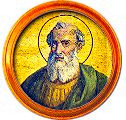Papa Víctor I
Si Papa Víctor I ang Obispo ng Roma mula 189 CE hanggang 199 CE. Ayon sa Vatikano, ito ay mula 186 CE o 189 hanggang 197 o 201 CE.[1] Siya ang unang obispo ng Roma na ipinanganak sa probinsiyang Romano ng Aprika. Malamang na siya ay ipinanganak sa Leptis Magna (o Tripolitania). Siya ay kalaunang kinanonisa at ang kanyang pista ay pinagdiriwang sa Simbahang Katoliko Romano tuwing Hulyo 28 bilang "San Victor I, Papa at Martir". [2] Bago ang kanyang pagluklok sa episkopasiyang Romano, ang isang pagkakaiba sa pagpepetsa ng pagdiriwang ng Pascha(easter) sa pagitan ng Roma at mga obispo ng Asya menor ay pinayagan ng parehong mga simbahan sa Roma at silangan. Ipinagdiriwang ito ng mga simbahan sa Asya menor tuwing ika-14 ng buwang Nisan ng mga Hudyo na araw bago ang paskuwa ng mga Hudyo nang hindi isinasaalang kung anong araw ng linggo it mahulog dahil ang pagpapako ni Hesus ay nangyari sa Biyernes bago ang paskuwa. Tinawag ang mga ito ng Latin na Mga Quartodeciman. Ipinagdiriwan ng Roma at Kanluran ang Pascha tuwing linggo kasunod ng ika-14 ng Nisan. Si Victor I ay naaalala sa kanyang malaking pagkabahala na kanyang ipinakita para sa kaayusan ng simbahan sa pamamagitan ng pagputol ng mga kaugnayan sa mga obispong gaya nina Polycrates ng Efeso na sumalungat sa kanyang mga pananaw tungkol sa Pascha.[3] Siya ay kumalas rin kay Theodotus ng Byzantium dahil sa mga paniniwala nito tungkol kay Kristo.[4]
| Papa San Víctor I | |
|---|---|
 | |
| Nagsimula ang pagka-Papa | 189 |
| Nagtapos ang pagka-Papa | 199 |
| Hinalinhan | Eleuterio |
| Kahalili | Ceferino |
| Mga detalyeng personal | |
| Pangalan sa kapanganakan | Victor |
| Kapanganakan | date unknown Roman Africa |
| Yumao | 199 Rome, Roman Empire |
| Iba pang mga Papa na mayroon ding pangalan na Victor | |
Hanggang sa panahon ni Victor, ang Roma ay nagdiriwang ng misa sa Griyego. Binago ni Victor ang wika nito sa Latin na ginagamit sa kanyang katutubong Hilagang Aprikano. Ayon kay Jeronimo, siya ang unang may akdang Kristiyano na sumulat tungkol sa teolohiya sa wikang Latin. Gayunpaman, ang mga misang Latin ay hindi naging pangkalahatan hanggang sa huli ng ika-4 na siglo CE.[5]
May ilang nagmumungkahi na siya ang unang itim na Aprikanong papa ng Simbahang Katoliko Romano.[6]
Mga sanggunian
baguhin- ↑ He was the first Pope from Africa. In fact "Liber Pontificalis" "The Oxford Dictionary of Popes" and "The Original Catholic Encyclopedia" list him as being native to Africa. There seems to be no original work written that list him as a Roman Citizen or native/descendant of Rome. The dates assigned to Victor’s episcopate by the ancient authorities vary greatly. Eusebius here puts his accession in the tenth year of Commodus (i.e. 189 a.d.), and this is accepted by Lipsius as the correct date. Jerome’s version of the Chron. puts his accession in the reign of Pertinax, or the first year of Septimius Severus (i.e. 193), while the Armenian version puts it in the seventh year of Commodus (186). Eusebius, in his History, does not state directly the duration of his episcopate, but in chap. 28 he says that Zephyrinus succeeded him about the ninth year of Severus, i.e. according to his erroneous De Viris Illustribus, assigns him ten years; the Armenian version of the Chron. twelve years. The Iberian Catalogue makes his episcopate something over nine years long; the Felician Catalogue something over ten. Lipsius, considering Victor in connection with his successors, concludes that he held office between nine and ten years, and therefore gives as his dates 189–198 or 199 (see p. 172 sq.). According to an anonymous writer quoted in chap. 28, Victor excommunicated Theodotus of Byzantium for teaching that Christ was a mere man. He is best known, however, on ccount of his action in connection with the great Quartodeciman controversy (see chap. 24). Jerome, in his version of the Chron., says of him cujus mediocria de religione extant volumina, and in his de vir. ill. chap. 34, he tells us that he wrote upon the passover, and also some other works (super quaestione Paschae, et alia quaedam scribens opuscula). Harnack believes that he has discovered one of these works (all of which have been supposed lost) in the Pseudo-Cyprianic de Aleatoribus. In his Texte und Unters. Bd. V. Heft 1, he has discussed the subject in a very learned and ingenious manner. The theory has much to commend it, but there are difficulties in its way which have not yet been removed; and I am inclined to think it a product of the first half of the third century, rather than of the last quarter of the second (see the writer’s review of Harnack’s discussion in the Presbyterian Review, Jan., 1889, p. 143 sqq.). Schaff, Philip: The Nicene and Post-Nicene Fathers Second Series Vol. I. Oak Harbor : Logos Research Systems, 1997, S. 3
- ↑ See the General Roman Calendar of 1954
- ↑ Eusebius Pamphilius: Church History, Life of Constantine, Oration in Praise of Constantine, Ch. XXIV
- ↑ Eusebius Pamphilius: Church History, Life of Constantine, Oration in Praise of Constantine, Ch. XXVIII
- ↑ Kung, Hans. The Catholic Church: A Short History. New York; The Modern Library, 2003, p.44
- ↑ Taryor, N. K., (1984) Impact of the African Tradition on African Chrisitanity (The Strugglers Community Press; Chicago), p168
Ang lathalaing ito na tungkol sa Katolisismo ay isang usbong. Makatutulong ka sa Wikipedia sa pagpapalawig nito.